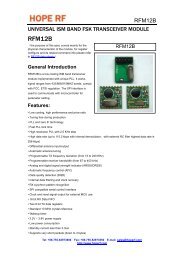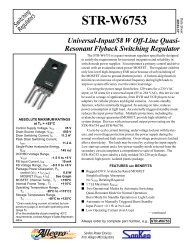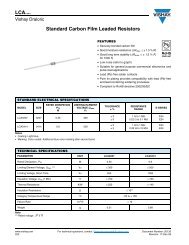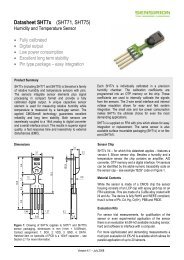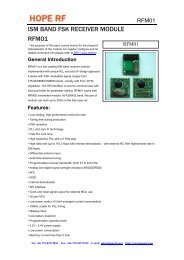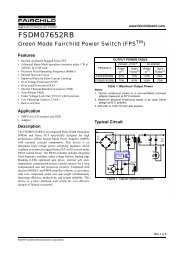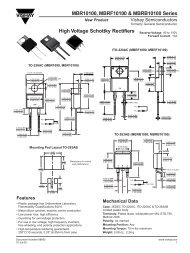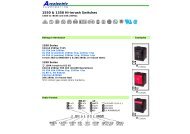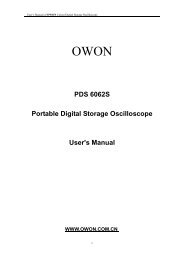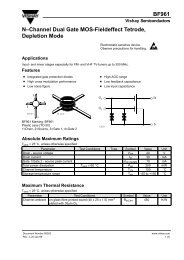LM3886 High-Performance 68W Audio Power Amplifier w Mute
LM3886 High-Performance 68W Audio Power Amplifier w Mute
LM3886 High-Performance 68W Audio Power Amplifier w Mute
Create successful ePaper yourself
Turn your PDF publications into a flip-book with our unique Google optimized e-Paper software.
External Components Description (Figures 1 and 2 )<br />
Components<br />
Functional Description<br />
1 R IN Acts as a volume control by setting the voltage level allowed to the amplifier’s input terminals<br />
2 R A Provides DC voltage biasing for the single supply operation and bias current for the positive input<br />
terminal<br />
3 C A Provides bias filtering<br />
4 C Provides AC coupling at the input and output of the amplifier for single supply operation<br />
5 R B Prevents currents from entering the amplifier’s non-inverting input which may be passed through to<br />
the load upon power-down of the system due to the low input impedance of the circuitry when the<br />
under-voltage circuitry is off This phenomenon occurs when the supply voltages are below 15V<br />
6 C C Reduces the gain (bandwidth of the amplifier) at high frequencies to avoid quasi-saturation<br />
oscillations of the output transistor The capacitor also suppresses external electromagnetic<br />
switching noise created from fluorescent lamps<br />
7 Ri Inverting input resistance to provide AC Gain in conjunction with R f1 <br />
8 Ci Feedback capacitor Ensures unity gain at DC Also a low frequency pole (highpass roll-off) at<br />
f c e 1(2qRi Ci)<br />
9 R f1 Feedback resistance to provide AC Gain in conjunction with Ri<br />
10 R f2 At higher frequencies feedback resistance works with C f to provide lower AC Gain in conjunction<br />
with R f1 and Ri A high frequency pole (lowpass roll-off) exists at<br />
f c e R f1 R f2 (s a 1R f2 C f )(R f1 a R f2 )(s a 1C f (R f1 a R f2 ))<br />
11 C f Compensation capacitor that works with R f1 and R f2 to reduce the AC Gain at higher frequencies<br />
12 R M <strong>Mute</strong> resistance set up to allow 05 mA to be drawn from pin 8 to turn the muting function off<br />
x R M is calculated using R M<br />
s (lV EEl b 26V)I8 where I8 t 05 mA Refer to the <strong>Mute</strong><br />
Attenuation vs <strong>Mute</strong> Current curves in the Typical <strong>Performance</strong> Characteristics section<br />
13 C M <strong>Mute</strong> capacitance set up to create a large time constant for turn-on and turn-off muting<br />
14 R SN Works with C SN to stabilize the output stage by creating a pole that eliminates high frequency<br />
oscillations<br />
15 C SN Works with R SN to stabilize the output stage by creating a pole that eliminates high frequency<br />
oscillations<br />
f c e 1(2qR SN C SN )<br />
16 L Provides high impedance at high frequecies so that R may decouple a highly capacitive load<br />
17 R and reduce the Q of the series resonant circuit due to capacitive load Also provides a low<br />
impedance at low frequencies to short out R and pass audio signals to the load<br />
18 C S Provides power supply filtering and bypassing<br />
19 S1 <strong>Mute</strong> switch that mutes the music going into the amplifier when opened<br />
Optional components dependent upon specific design requirements Refer to the Application Information section for more information<br />
OPTIONAL EXTERNAL COMPONENT INTERACTION<br />
Although the optional external components have specific desired functions that are designed to reduce the bandwidth and<br />
eliminate unwanted high frequency oscillations they may cause certain undesirable effects when they interact Interaction may<br />
occur for components whose reactances are in close proximity to one another One example would be the coupling capacitor<br />
C C and the compensation capacitor C f These two components act as low impedances to certain frequencies which will couple<br />
signals from the input to the output Please take careful note of basic amplifier component functionality when designing in these<br />
components<br />
The optional external components shown in Figure 2 and described above are applicable in both single and split voltage supply<br />
configurations<br />
6



